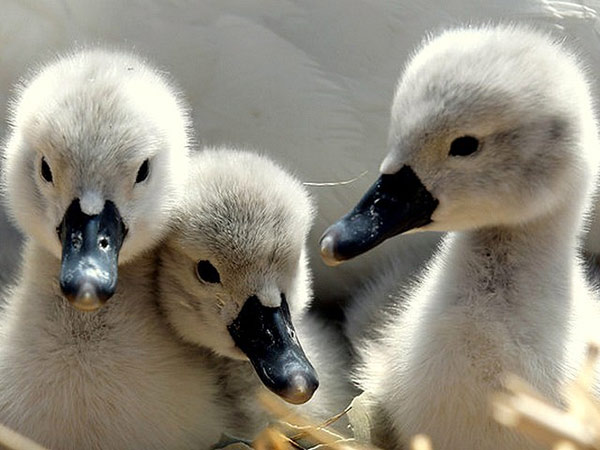Everything You Need To Know About Baby Swans (Cygnets)

Swans are among the most elegant and graceful birds in the world. But before they grow into their magnificent adult forms, they start as adorable and fluffy cygnets. If you've ever wondered about baby swans, their behavior, diet, and development, this guide will cover everything you need to know about these fascinating creatures.
Nest
Swans build their nests in secluded, quiet locations near water bodies such as lakes, ponds, or slow-moving rivers. The nests are typically large, made of sticks, reeds, and grass, and are constructed by both parents, although the female, or pen, does most of the building.
Key Facts About Swan Nests:
- Nests can be several feet wide and are often reused in following years.
- The pen lays between 4 to 10 eggs, which are incubated for about 35 to 41 days.
- Both parents guard the nest fiercely against predators and intruders.
- Once hatched, cygnets leave the nest within 24 hours to explore their surroundings under the watchful eyes of their parents.
What Do Baby Swans Look Like
Baby swans, or cygnets, look very different from their adult counterparts. They are small, fluffy, and covered in soft down feathers. Their appearance varies depending on the species of swan:
- Mute Swan Cygnets – Typically gray or brown with a dark bill.
- Trumpeter Swan Cygnets – Usually light gray with a pinkish bill that darkens as they grow.
- Whooper Swan Cygnets – Light gray to brown with a darker beak.
- Black Swan Cygnets – Gray with a hint of black.
Most cygnets retain their grayish color for several months before their feathers gradually turn white (or black, depending on the species). Their legs and feet are usually dark gray or black, and their bills develop color as they mature.
What Kind of Food Do Baby Swans Eat?
Cygnets have a different diet from adult swans. While adult swans primarily feed on aquatic vegetation, baby swans consume a mix of small invertebrates and plant matter to support their rapid growth.
What Cygnets Eat in the Wild:
- Aquatic insects such as larvae and small crustaceans
- Algae and pondweed
- Soft plant material from underwater vegetation
- Small fish and tadpoles (occasionally)
What Cygnets Eat in Captivity:
For cygnets raised in captivity or by wildlife rehabilitators, their diet is supplemented with:
- Specialized waterfowl pellets
- Leafy greens such as spinach and lettuce
- Oats and grains in small amounts
- Boiled eggs (mashed) for extra protein
At around 6 to 8 weeks of age, cygnets transition to a more herbivorous diet, resembling that of adult swans.
Frequently Asked Questions About Baby Swans
What is a baby/young swan called?
A baby swan is called a cygnet. The term comes from the Latin word "cygnus," meaning swan. As they mature, young swans may also be referred to as juveniles before reaching adulthood.
How many cygnets do swans have?
The number of cygnets in a brood varies depending on the species and environmental conditions. On average, swans lay between 4 to 10 eggs, but not all cygnets may survive due to predation or environmental factors.
Survival Rates of Cygnets:
- In the wild, cygnets face threats from predators like foxes, large fish, and birds of prey.
- Harsh weather and lack of food can also affect survival rates.
- Swans in protected areas or captivity tend to have higher survival rates.
At what age do baby swans turn white?
Cygnets go through a gradual color transformation as they mature. Most species of swans, particularly the mute, whooper, and trumpeter swans, start turning white between 6 to 12 months of age.
Key milestones in their color change include:
- 0 to 3 months: Fluffy gray or brown feathers.
- 4 to 6 months: Some white feathers begin to appear.
- 6 to 12 months: More white feathers emerge, replacing the gray down.
- By 1.5 to 2 years: Most swans have completely white plumage.
However, black swans remain black throughout their lives, with their cygnets changing from gray to darker plumage over time.
How long do baby swans stay with parents?
Cygnets typically stay with their parents for around 6 to 9 months, depending on the species and environmental factors.
- During the first few weeks, cygnets stay close to their parents for protection and warmth.
- By 3 to 4 months, they begin to explore more independently but still rely on their parents for guidance.
- By 6 to 9 months, cygnets start learning to fly and may begin separating from their family.
- Some swans drive their young away once they reach full independence, while others tolerate them in the territory for longer periods.
By the time they reach one year old, most cygnets have completely left their parents and joined other juvenile swans to find mates and form their own families.
Swans are majestic birds with a fascinating life cycle, and their cygnets undergo incredible transformations before reaching adulthood. Whether you're observing them in the wild or caring for them in captivity, understanding their behavior and needs can help you appreciate these beautiful creatures even more!